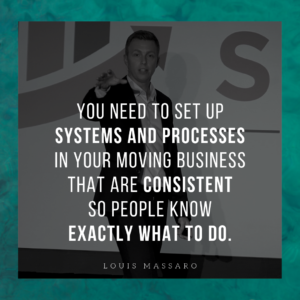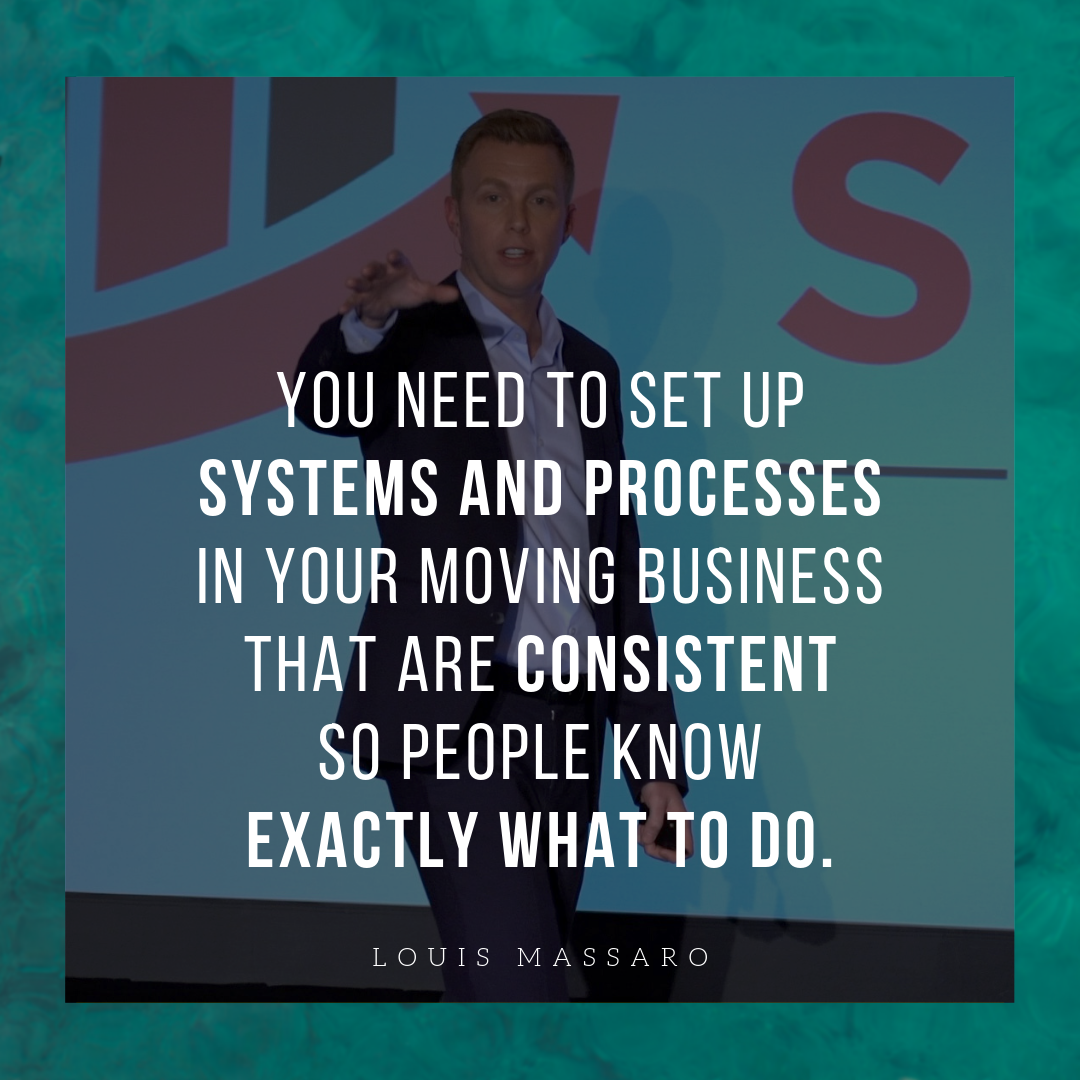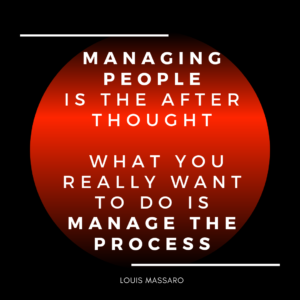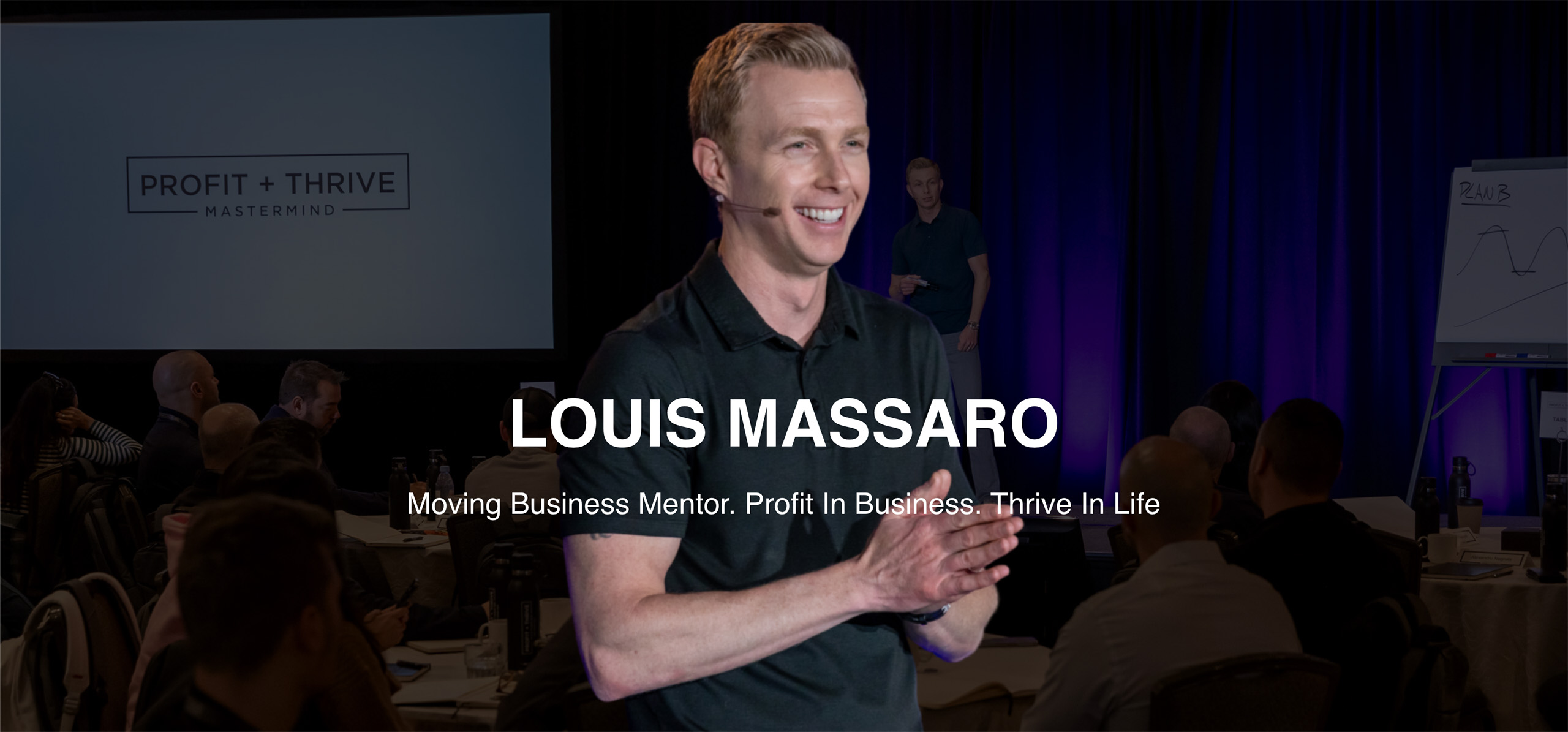► Get New Posts Via Email ► Get This Episode On iTunes
SUMMARY
In this video, Louis Massaro shares how to create processes in your moving company.
- “Identify” Identify the areas where having a written process would really benefit your company.
- “Clarify” List out the steps of the process.
- “Formalize” Create an actual SOP, Standard Operating Procedure, for the process.
- “Organize” Create the original document in Word, or on Google Docs, to have those documents put away for administrative use only and have PDF versions available for the whole company.
- “Implement” It becomes a lot easier to find someone who can follow instructions, as opposed to finding someone who’s going to create and establish a new path that happens to also be in line with your vision and your goals.
- “Improve” You want to be able to tweak this process, you want to be able to ask for feedback from people that are involved.
- Watch the video to get full training.
HOT NEWS & DEALS!
- Join the Moving CEO Challenge: Official Louis Massaro Community Facebook Group! A place for moving company owners to connect, share ideas, and inspire one another. Click here to join!
- Latest Instagram!
Check out @LouisMassaro for new announcements, valuable tips, and enlightening videos to take your moving company to the NEXT LEVEL!
RELATED POSTS
Mover Recruiting Process [Download]
Why Your Moving Company Is Losing Money
How To Turn Moving Leads Into Dollars
How To Provide Accurate Moving Estimates
Setting Up Your Moving Company’s Referral Program



TRANSCRIPTION
Hey, my friend, it’s Louis Massaro, CEO of Moving Mastery where we help moving company owners set up proven systems and processes, so they can increase profits, reduce stress, and live a better quality of life. I have clients come to me often with the same concern as most businesses, that they want to have a smooth-running, predictable, money-making machine. And, have employees, and staff, and team that do things consistently without them having to be there all the time on top of it.
But, what they find is that as they start to grow, as they start to take that next step to the next level, and grow a little bit, bring on additional staff, things start falling between the cracks. People don’t do things exactly how they’re supposed to be doing them. Which is super frustrating, because even though you’ve set up this really great business, you’ve got your leads coming in, you’ve got your calls, you’re booking moves, you’re going out, you’re servicing them, you’re doing a great job for your customers. Now you want to grow, now you want to scale. But, what happens is the bigger you get, creates room for error, and for people to drop the ball. Which, just causes you to feel like, “You know what? Maybe I shouldn’t grow. Maybe I shouldn’t expand. Let me just jump back in and do everything myself.”
What I tell people is that if you want to do one thing that’s going to help you scale, that’s going to help you grow, that’s going to help you get to that next level without distress, without the overwhelm, and with the consistency you need to set up systems and processes in your business that are consistent so people know exactly what to do.
I have this small group of private clients that, they come to my office, and we actually spend a full day, eight hours, going through the process of learning the process of process management. Let me say that again. It’s the process of process management. How to set up the processes, how to manage the processes, how to make sure they’re being implemented and adhered to. And, it’s one of those things that once they are able to establish that, which is a fundamental piece if you want to scale and you want to grow your business, without the headache, without the stress, without feeling like you’ve taken three steps forward and one step back. And, you’re constantly kind of doing that front and back motion, where you just want to go straight up. You need to set up these processes, and it all starts with the process of process management.
Like I said, they come and we spend a full day going through this. There’s so much to it, but I wanted to give you the key elements here, because a lot of people have been asking, “Louis, how do you set up processes? What are the steps so that we could have a consistent, smooth-running business?” I’m going to lay them out for you right now, okay?
First thing you need to do in order to set up your processes is, it’s called identify. You need to identify the processes that you’re going to need. In the group that comes to my office, I take them through this process and give them a sheet called the Process Identifier when we go through it. But, essentially what you want to do is you want to look at what new initiatives you have going on. Maybe you are going to start doing box deliveries, let’s just say. Or, maybe you’re going to start doing upsells on your confirmation call. Anything new that you want to do is a perfect opportunity to start writing out a process for it.
If there’s maybe any repetitive tasks, things that happen over, and over, and over, and over again that need to be done consistently. I’m thinking maybe your confirmation call would be a great … a few days out before the move if you’re calling to do a confirmation, having that process written down, having your morning dispatch process all written out. You want to be able to identify because what stops a lot of people when it comes to creating processes for their business is that they think they need to have a complete book of processes for every single action that happens within the company.
Although that’s an admiral goal to get to, it starts with one process. Then, another process, and then another process. What you want to do is you want to identify where would having a … Because remember, you don’t want to have a process just for the sake of having them. But, where would you benefit the most by having a document that’s written, that shows step by step how to do something in your business? If you think about maybe where people drop the ball, or where somebody needs to … maybe you’re doing something for storage billing, and the way that, that’s handled. The exact steps. If you take the time to list those out and write those out, and then you could hand that off to somebody, and they do it the same way every time. That’s how you grow without going three steps forward, one step back.
But, what happens is, if we don’t identify these processes and start putting them in place, you might have people and you’re like, “No, but they know how to do it, Louis. Don’t worry, they’ve been doing it forever.” But, what happens if they leave? What happens if you need to fire that person, and you are nervous to do it because you’re like, “They’re the only ones that know how to do what they do.” Right? Or, you try to roll out some new initiative and it just goes wrong, and causes maybe some customer service issues. Identify the areas where having a written process would really benefit your company.
The second thing you want to do, is you want to clarify those. With my group that comes here, we take them through a process, and with a sheet called a Process Clarifier. Once they’ve identified the processes that are going to be the most impactful to their business. Not just processes for the sake of having processes, but which ones would be the most impactful, now we need to clarify those. When you clarify those, basically what you’re doing is you’re laying out the steps. You’re either doing bullet points, or you’re doing a visual flowchart or some type of mind map, or you’re drawing it out on a whiteboard. Whatever it is, you’ve got to be able to clarify exactly what that process is. Just list the steps. That’s the easiest thing you can do, is just list them out. Step one, they do this. Step two, this.
If this, then that. And, you just list it all out without trying to make some kind of fancy formalized document. You keep it very simple. When I run them through the process, we do it pen and paper. We don’t even do it on the computer. Pen and paper, just list out the processes. List out the steps of the process.
The third thing, once you have that. You’ve identified them, you’ve gotten clarity on each individual process, which you’ll do one at a time. The next step is, you formalize that process. You create an actual SOP, Standard Operating Procedure, for that. I give them a template that they go through, and they have it all standardized so that they’re exactly the same. What you want to do is you just want to have your own template, have some consistency in the way that you create these SOP’s. Let’s say somebody … the clarifier, you could have people in different departments write those out.
Let’s say you need help and you want your dispatcher to write out the process that they go through in the morning to send out the crews. What would happen is you’d take that, and you really want one person that will then take those and put them into a formalized SOP. This way they’re just all consistent. They read the same way, they’re laid out the same way, so whoever’s using them can totally understand what’s going on. Because, once you have them it’s not just to store them away, it’s there to be used daily for the function of your business.
Somebody’s unsure about how something works, they look up the SOP. They look up the process. They come to … a sales person goes to the sales manager and says, “Hey, how do I do this?” The sales manager knows, “Hey, we have a process for that. Hey, I’m going to send you this process.” Or, “Go in the repository, find it, it’s all there.” This way you’re not constantly having to tell people how to do things over and over. You’re showing them how to do it, and it’s exactly how you want it done.
When it comes to managing people, you really … Managing people’s the after thought. What you really want to do is manage the process, and you just want to have the people, and get them back in line with the process. That’s how you really manage the people. By having it all in writing makes it much, much easier to do.
Fourth step what you want to do, is you want to organize these processes. You want to have a place, they call it a repository, where it’s just a filing system of where you keep all of these. For me, we kept it in something similar to a Dropbox, or a Google Drive. With a folder that says, “SOP’s.” You double click on that folder, it opens up, and then it’s got sales SOP’s, dispatch SOP’s, customer service SOP’s, accounting SOP’s. You double click those, the SOP’s are in there. There’s also softwares and things like that, that you could use. But, you want to have a repository, you want to have a place where all of these processes are easy to find.
One of the biggest wastes of time would be to go out and create a bunch of processes, put them in a filing system, and then nobody uses them because nobody could find them. You want to have them organized in a way where people could easily find them as they need them. Of course, you could print them out and put them in a binder as well, where people can find them. But, nowadays it’s much easier just to be able to find them with a few clicks and pull up a PDF of that. My recommendation is if you create the original document in Word, or on Google Docs, to have those documents put away for administrative use only, so they can’t be modified by anyone. Then, have PDF versions available for the whole company. Make sense?
You want to then after that, fifth step is you want to implement. You have to now take this and implement it. You want to get anybody that’s involved in this new process that you’re rolling out, and you want to sit them down, and talk to them. And say, “Well, here’s what’s going on, here’s what the steps.” You want to pick the start date, you want to train your team, but you also want to set clear expectations so that they know what’s expected, and that they understand the process. If they have questions, if they start to poke holes in the process and you’re like, “Oh yeah, you’re right. We didn’t account for that.” Then, you make some adjustments.
But, if you just roll it out and don’t tell anybody about it, nobody can implement it, you can’t get any feedback from them to be able to help you improve the process. Because remember, it’s all about making your business run smoothly and efficiently like a machine. If you think about McDonald’s for example. The reason McDonald’s is so successful and has so many locations across the world is not because of the people that are working there, it’s because of their processes. Their managers, all they need to do is get people back in line with those processes. The better that you have these laid out, you don’t have to go search for these, the staff that you need. It becomes a lot easier to staff your business. Let’s put it that way.
It becomes a lot easier to find someone who can follow instructions, as opposed to find someone whose going to create and establish a new path that happens to also be in line with your vision and your goals. It never works out.
The sixth step once you get all this in place, you get all this going, is you want to improve. You want to always improve these processes. Here’s the thing, you want to be able to tweak this process, you want to be able to ask for feedback from people that are involved. And, you need to make sure that people are following the processes, and if they’re not …
Let’s say you roll out a process, and people start doing it a different way. They skip a few steps, or they find some other work around. This is really where you would want the person who’s in charge of your processes, your process manager, your operations manager, to come in and find where this stuff’s happening, is to … Maybe the way that you originally wrote it needs an adjustment. Maybe somebody in the company found a better way of doing it. Okay, great. But, update the process so that you can manage your business, so that you could look and say, “Here’s how things are supposed to be getting done, and here’s how everybody’s doing them. Is it like this, or is it something different?”
When you have the processes in black and white, things will completely change for your business. Here’s what I want you to do, because a lot of people get overwhelmed with the idea of, “I need to create these processes,” and all this. It can be as simple as getting out a sheet of paper, and just writing down the steps of how you want something to happen. You’re not good on computers? No problem. Write it on the back of a napkin if you have to, and hand it to the person who needs to be fulfilling that task, and tell them, “These are the steps, exactly how I need you to do it.”
I’m just trying to illustrate a point, that it doesn’t have to be so hard. It doesn’t have to be so challenging, but you need this reference point. To be able to come back to make sure that things are getting done the way you want them done. This is the only way you’re going to be able to scale. If you’re in a position where you’re like, “Hey Louis, it sounds like a lot of work. I’m happy, I don’t want to scale, I don’t want to grow. I don’t want any more employees, everybody’s doing things just fine. If there’s a problem, they come to me. I’m good with that.” Cool, no problem.
But, if you’re like, “Hey Louis, every time I try to take a few steps forward I end up getting knocked back because people aren’t doing things the right way. I’m having a tough time managing people. I’m having a tough time getting them to do what I want. There’s inconsistent service happening across the board. We don’t do things the same way all the time.” If that’s you and you want to make it better, this is the one thing you could do, is implement processes into your business. Those are the steps. Again, identify, clarify, formalize, organize, implement, and improve.
I hope that was helpful my friend. If so, do me a favor. Share this with someone out there in any business that you think might find this helpful, or useful. I’d really appreciate it if you’d like this video as well. Until I see you next time, go out there every single day, profit in your business, thrive in your life, I’ll see you later my friend.
